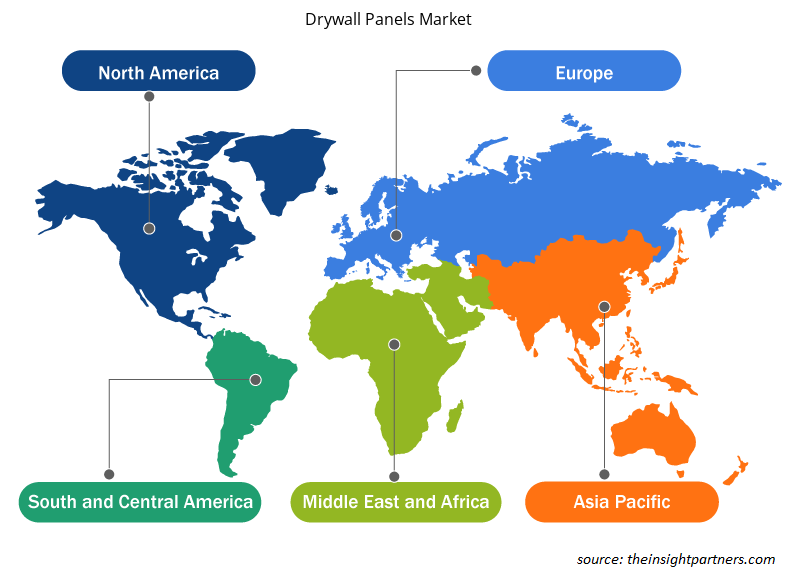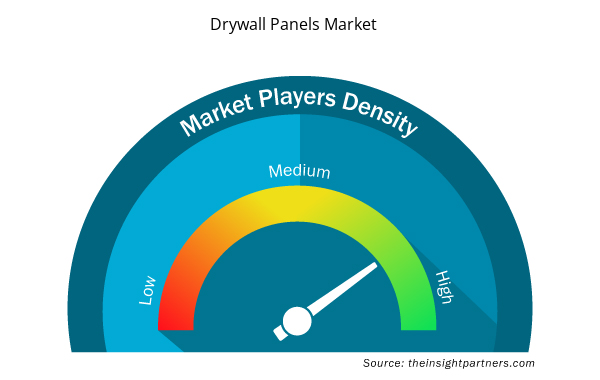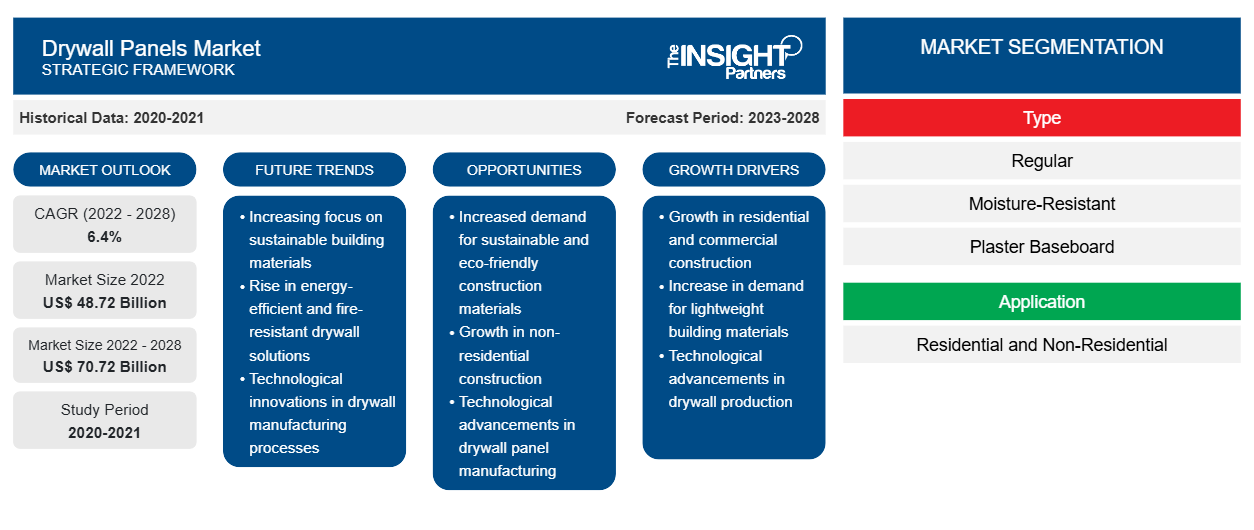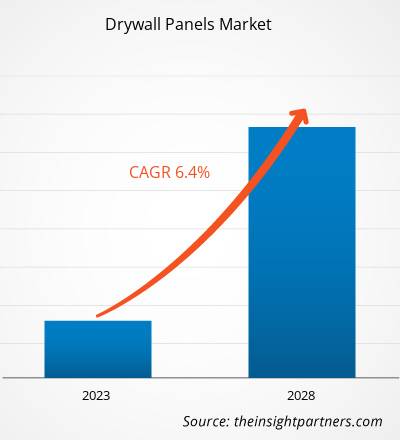预计干式墙板市场规模将从 2022 年的 487.1996 亿美元增长到 2028 年的 707.2339 亿美元;预计从 2022 年到 2028 年的复合年增长率为 6.4%。
干式墙板也称为墙板、石膏板、石膏板和灰泥板。干式墙板由夹在两层特殊纸之间的一层石膏组成。它们是包裹柱子、天花板、墙壁和隐藏钢梁的绝佳选择。干式墙板是最广泛使用和最受欢迎的建筑元素之一。它是许多家庭装修和翻新不可或缺的附加物。
2022 年,亚太地区占据了全球干式墙板市场的最大收入份额。亚太干式墙板市场分为澳大利亚、中国、印度、日本、韩国和亚太其他地区。由于住宅和非住宅领域对干式墙板的使用越来越多,亚太地区对干式墙板的需求正在增加。不断发展的建筑业是该地区干式墙板市场增长的重要贡献者。例如,在印度,建筑业是仅次于农业的第二大产业,占该国 GDP 的约 11%。此外,预计到 2030 年,中国每年将在建筑建设上投入 13 万亿美元。根据中国国家统计局的数据,中国建筑产值从 2010 年的 1.51 万亿美元增长到 2020 年的 4.18 万亿美元。此外,亚太地区石膏板市场的参与者正在大力投资研发活动,并专注于扩大生产能力,推动该地区石膏板市场的增长。
定制此报告以满足您的需求
您可以免费定制任何报告,包括本报告的部分内容、国家级分析、Excel 数据包,以及为初创企业和大学提供优惠和折扣
- 获取此报告的关键市场趋势。这个免费样品将包括数据分析,从市场趋势到估计和预测。
COVID-19 疫情对石膏板市场的影响
在 COVID-19 疫情爆发之前,石膏板市场主要受住宅和非住宅建筑活动使用量的增加所驱动。然而,COVID-19 疫情阻碍了化学品和材料行业以及石膏板市场的增长。为抗击 SARS-CoV-2 传播而实施的措施对各行业的增长产生了负面影响。由于许多工厂长期停工,建筑商在进口原材料和场外建筑材料方面遭遇延误和成本增加。疫情对建筑业的影响造成的损害阻碍了对石膏板的需求。
随着各国政府宣布放宽限制,全球市场正在从损失中恢复。制造商被允许满负荷生产,这有助于他们弥补供应缺口。预计这将对石膏板市场增长产生积极影响。
市场洞察
全球建筑业崛起
干式墙板用于建造住宅和非住宅建筑的内墙、天花板和隔墙。它们用于直接装饰或蓟灰泥饰面。干式墙板比灰泥更受欢迎,因为它更容易安装和维修、更便宜、更耐用。由于所有这些好处,干式墙板在住宅和非住宅建筑活动中的使用越来越多。全球各国的建筑业正在迅速发展。政府投资的增加和住宅建筑需求的增加推动了建筑业的增长。美国、中国和印度等国家拥有世界上最大的建筑业务。在北美,建筑业是该地区经济的重要贡献者之一。由于人口增加和该地区商业部门的快速增长,建筑活动的增加推动了北美建筑业的发展。在亚太地区,建筑活动有所增加。该地区人口的增加给现有的基础设施带来了压力,需要开发新的铁路网络、住宅建筑和道路。因此,全球各国的高建筑活动率对各种建筑材料(包括干墙板)产生了巨大的需求。
类型洞察
根据类型,全球石膏板市场细分为普通、防潮、石膏踢脚板、无纸、X 型和其他。2022 年,普通石膏板市场份额最大。普通石膏板也称为白板,通常一面为白色,另一面为棕色。普通石膏板是没有特殊特征的普通石膏板。这种普通石膏板广泛用于住宅和非住宅建筑。普通石膏板通常用于卧室、客厅、走廊和地下室。它是最具成本效益的石膏板类型,有多种厚度可供选择。
全球石膏板市场的主要参与者包括 Georgia-Pacific LLC、American Gypsum Co LLC、Yoshino Gypsum Co Ltd、Compagnie de Saint Gobain SA、Sadaf Gypsum Co、Knauf Gips KG、Isam Khairi Kabbani Group、National Gypsum Co、Technomec Building Industries LLC 和 GYPSEMNA Co LLC。全球石膏板市场的参与者专注于提供高质量的产品以满足客户需求。他们还专注于投资研发活动、新产品发布和扩大生产能力等战略。
石膏板市场区域洞察
Insight Partners 的分析师已详尽解释了预测期内影响石膏板市场的区域趋势和因素。本节还讨论了北美、欧洲、亚太地区、中东和非洲以及南美和中美洲的石膏板市场细分和地理位置。

- 获取石膏板市场的区域特定数据
石膏板市场报告范围
| 报告属性 | 细节 |
|---|---|
| 2022 年市场规模 | 487.2亿美元 |
| 2028 年市场规模 | 707.2亿美元 |
| 全球复合年增长率(2022 - 2028) | 6.4% |
| 史料 | 2020-2021 |
| 预测期 | 2023-2028 |
| 涵盖的领域 | 按类型
|
| 覆盖地区和国家 | 北美
|
| 市场领导者和主要公司简介 |
|
石膏板市场参与者密度:了解其对业务动态的影响
石膏板市场正在快速增长,这得益于终端用户需求的不断增长,这些需求源于消费者偏好的不断变化、技术进步以及对产品优势的认识不断提高等因素。随着需求的增加,企业正在扩大其产品范围,进行创新以满足消费者的需求,并利用新兴趋势,从而进一步推动市场增长。
市场参与者密度是指在特定市场或行业内运营的企业或公司的分布情况。它表明在给定市场空间中,相对于其规模或总市场价值,有多少竞争对手(市场参与者)存在。
在石膏板市场运营的主要公司有:
- 乔治亚太平洋有限责任公司
- 美国石膏有限公司
- 吉野石膏株式会社
- 圣戈班公司
- 萨达夫石膏公司
免责声明:上面列出的公司没有按照任何特定顺序排列。

- 获取石膏板市场顶级关键参与者概述
报告亮点
- 石膏板市场的渐进式行业趋势可帮助参与者制定有效的长期战略
- 发达市场和发展中市场采用的业务增长战略
- 2020 年至 2028 年石膏板市场的定量分析
- 全球石膏板需求量估计
- 波特五力分析说明了行业内买家和供应商的效力
- 了解竞争市场状况的最新发展
- 市场趋势和前景,以及推动和抑制石膏板市场增长的因素
- 通过强调支撑商业利益的市场策略来协助决策过程,从而促进市场增长
- 不同节点的石膏板市场规模
- 市场的详细概述和细分,以及石膏板行业动态
- 各地区干式墙板市场规模及增长机遇
全球石膏板市场
根据类型,石膏板市场分为普通、防潮、石膏踢脚板、无纸、X 型和其他。根据用途,石膏板市场分为住宅和非住宅。
公司简介
- 乔治亚太平洋有限责任公司
- 美国石膏有限公司
- 吉野石膏株式会社
- 圣戈班公司
- 萨达夫石膏公司
- 可耐福吉普两合公司
- Isam Khairi 卡巴尼集团
- 国家石膏公司
- Technomec 建筑工业有限责任公司
- GYPSEMNA 有限责任公司
- 历史分析(2 年)、基准年、预测(7 年)及复合年增长率
- PEST 和 SWOT 分析
- 市场规模价值/数量 - 全球、区域、国家
- 行业和竞争格局
- Excel 数据集



Report Coverage
Revenue forecast, Company Analysis, Industry landscape, Growth factors, and Trends

Segment Covered
This text is related
to segments covered.

Regional Scope
North America, Europe, Asia Pacific, Middle East & Africa, South & Central America

Country Scope
This text is related
to country scope.
常见问题
Drywall panels are widely used as a substitute for wooden panels and concrete walls in modern buildings and interiors, as they can be installed easily and quickly. Also, they are lightweight, flexible to use, cost-effective, and durable. Drywall panels also consist of recycled content. These panels are available in different colors and varieties, which helps add desirable and luxurious aesthetics to the interiors of a building. Due to all these factors, the use of drywall panels is growing in residential, commercial, industrial, and utility spaces, such as homes, offices, institutions, recreation centers, hotels, hospitals, and restaurants.
During the forecast period, type X is expected to be the fastest-growing segment. These panels are more difficult to cut and work with than regular drywall panels and are typically used in garages, rooms, and apartment buildings in accordance with several building codes. The majority of Type X drywall has a one-hour fire rating, while some have a fire rating of 30 minutes. The Type X drywall panels absorb sound slightly better than regular drywall and are slightly stronger than the regular 3/8-inch or 1/2-inch drywall panels. These factors are expected to boost the growth of the type X segment in the drywall panels market demand during the forecast period.
During the forecast period, the non-residential segment is expected to be the fastest-growing segment. Commercial places such as office buildings, hospitals, shopping malls, movie theatres, colleges and universities, hotels, restaurants, warehouses, and community halls require drywall panel installation during construction to protect the structure from fire, damage, mold, humidity, and extreme weather conditions. The non-residential sector is presumed to gather momentum significantly across the globe due to the increased demand for drywall panels from the hospitality sector, corporate offices, public places, and education facilities. These factors are expected to accelerate the growth of the non-residential segment of the drywall panels market.
In 2022, the regular segment held the largest market share. Factors such as efficiency, durability, ease of application, maintenance, and flexibility in all forms of ornamentation have made regular gypsum boards a preferable choice for customers. They also offer excellent fire resistance and sound isolation. Regular gypsum boards are also easy to repair, and installation and labor costs for the entire construction system are relatively cheap. These factors led to the dominance of the regular segment in 2022.
The major players operating in the drywall panels market are Georgia-Pacific LLC, American Gypsum Co LLC, Yoshino Gypsum Co Ltd, Compagnie de Saint Gobain SA, Sadaf Gypsum Co, Knauf Gips KG, Isam Khairi Kabbani Group, National Gypsum Co, Technomec Building Industries LLC, and GYPSEMNA Co LLC.
In 2022, Asia Pacific accounted for the largest share of the global drywall panels market. The demand for drywall panels in Asia Pacific is increasing due to the growing use of drywall panels in residential and non-residential sectors. The growing building & construction industry led to the dominance of Asia Pacific in 2022.
Trends and growth analysis reports related to Chemicals and Materials : READ MORE..
The List of Companies - Drywall Panels Market
- Georgia-Pacific LLC
- American Gypsum Co LLC
- Yoshino Gypsum Co Ltd
- Compagnie de Saint Gobain SA
- Sadaf Gypsum Co
- Knauf Gips KG
- Isam Khairi Kabbani Group
- National Gypsum Co
- Technomec Building Industries LLC
- GYPSEMNA Co LLC
The Insight Partners performs research in 4 major stages: Data Collection & Secondary Research, Primary Research, Data Analysis and Data Triangulation & Final Review.
- Data Collection and Secondary Research:
As a market research and consulting firm operating from a decade, we have published and advised several client across the globe. First step for any study will start with an assessment of currently available data and insights from existing reports. Further, historical and current market information is collected from Investor Presentations, Annual Reports, SEC Filings, etc., and other information related to company’s performance and market positioning are gathered from Paid Databases (Factiva, Hoovers, and Reuters) and various other publications available in public domain.
Several associations trade associates, technical forums, institutes, societies and organization are accessed to gain technical as well as market related insights through their publications such as research papers, blogs and press releases related to the studies are referred to get cues about the market. Further, white papers, journals, magazines, and other news articles published in last 3 years are scrutinized and analyzed to understand the current market trends.
- Primary Research:
The primarily interview analysis comprise of data obtained from industry participants interview and answers to survey questions gathered by in-house primary team.
For primary research, interviews are conducted with industry experts/CEOs/Marketing Managers/VPs/Subject Matter Experts from both demand and supply side to get a 360-degree view of the market. The primary team conducts several interviews based on the complexity of the markets to understand the various market trends and dynamics which makes research more credible and precise.
A typical research interview fulfils the following functions:
- Provides first-hand information on the market size, market trends, growth trends, competitive landscape, and outlook
- Validates and strengthens in-house secondary research findings
- Develops the analysis team’s expertise and market understanding
Primary research involves email interactions and telephone interviews for each market, category, segment, and sub-segment across geographies. The participants who typically take part in such a process include, but are not limited to:
- Industry participants: VPs, business development managers, market intelligence managers and national sales managers
- Outside experts: Valuation experts, research analysts and key opinion leaders specializing in the electronics and semiconductor industry.
Below is the breakup of our primary respondents by company, designation, and region:

Once we receive the confirmation from primary research sources or primary respondents, we finalize the base year market estimation and forecast the data as per the macroeconomic and microeconomic factors assessed during data collection.
- Data Analysis:
Once data is validated through both secondary as well as primary respondents, we finalize the market estimations by hypothesis formulation and factor analysis at regional and country level.
- Macro-Economic Factor Analysis:
We analyse macroeconomic indicators such the gross domestic product (GDP), increase in the demand for goods and services across industries, technological advancement, regional economic growth, governmental policies, the influence of COVID-19, PEST analysis, and other aspects. This analysis aids in setting benchmarks for various nations/regions and approximating market splits. Additionally, the general trend of the aforementioned components aid in determining the market's development possibilities.
- Country Level Data:
Various factors that are especially aligned to the country are taken into account to determine the market size for a certain area and country, including the presence of vendors, such as headquarters and offices, the country's GDP, demand patterns, and industry growth. To comprehend the market dynamics for the nation, a number of growth variables, inhibitors, application areas, and current market trends are researched. The aforementioned elements aid in determining the country's overall market's growth potential.
- Company Profile:
The “Table of Contents” is formulated by listing and analyzing more than 25 - 30 companies operating in the market ecosystem across geographies. However, we profile only 10 companies as a standard practice in our syndicate reports. These 10 companies comprise leading, emerging, and regional players. Nonetheless, our analysis is not restricted to the 10 listed companies, we also analyze other companies present in the market to develop a holistic view and understand the prevailing trends. The “Company Profiles” section in the report covers key facts, business description, products & services, financial information, SWOT analysis, and key developments. The financial information presented is extracted from the annual reports and official documents of the publicly listed companies. Upon collecting the information for the sections of respective companies, we verify them via various primary sources and then compile the data in respective company profiles. The company level information helps us in deriving the base number as well as in forecasting the market size.
- Developing Base Number:
Aggregation of sales statistics (2020-2022) and macro-economic factor, and other secondary and primary research insights are utilized to arrive at base number and related market shares for 2022. The data gaps are identified in this step and relevant market data is analyzed, collected from paid primary interviews or databases. On finalizing the base year market size, forecasts are developed on the basis of macro-economic, industry and market growth factors and company level analysis.
- Data Triangulation and Final Review:
The market findings and base year market size calculations are validated from supply as well as demand side. Demand side validations are based on macro-economic factor analysis and benchmarks for respective regions and countries. In case of supply side validations, revenues of major companies are estimated (in case not available) based on industry benchmark, approximate number of employees, product portfolio, and primary interviews revenues are gathered. Further revenue from target product/service segment is assessed to avoid overshooting of market statistics. In case of heavy deviations between supply and demand side values, all thes steps are repeated to achieve synchronization.
We follow an iterative model, wherein we share our research findings with Subject Matter Experts (SME’s) and Key Opinion Leaders (KOLs) until consensus view of the market is not formulated – this model negates any drastic deviation in the opinions of experts. Only validated and universally acceptable research findings are quoted in our reports.
We have important check points that we use to validate our research findings – which we call – data triangulation, where we validate the information, we generate from secondary sources with primary interviews and then we re-validate with our internal data bases and Subject matter experts. This comprehensive model enables us to deliver high quality, reliable data in shortest possible time.


 获取此报告的免费样本
获取此报告的免费样本